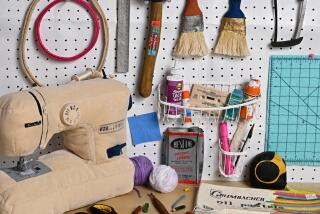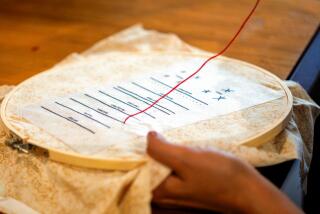A Stitch in Time Saves . . . Sanity
Cross-stitchers. Needlepointers. Lace-makers. Embroiderers.
Think of them as devoted. Artistic. Maybe even addicted. Just donât think of them as little old ladies in rocking chairs.
You can stick a pin in that stereotype, says Joan Cravens, director of the I Love Needlework Fair, which runs through Sunday aboard the Queen Mary in Long Beach and will attract hundreds of needle-craft enthusiasts from across the nation.
âTodayâs needleworker, according to surveys, is young--the average age is under 40,â Cravens says. âSheâs intelligent, usually with a college education. Sheâs fairly affluent, which gives her the leisure time to pursue this craft.â
And sheâs not always a she. âAlthough the majority of needlework hobbyists are still women, there are certainly growing numbers of men who are avid needle-crafters,â Cravens says. âItâs a relaxing escape, to pick up your needlework after a long day spent on the job, at the computer or in traffic. Medical studies have proved that doing needlework actually lowers your blood pressure as it calms and focuses you--I even know of therapists who prescribe it for their clients.â
Needleworking is, of course, an ancient craft, born first of necessity and then of vanity. During medieval times, membership in the embroiderersâ guilds was limited to men only. Women of high birth and their female servants, however, worked embroidery as an everyday craft inside their manor houses, embellishing clothing and linens.
The 17th and 18th centuries were the heyday of the âsamplerâ in England and America, as girls practiced stitching alphabets and moralistic sayings on pieces of linen, usually under the watchful eye of a governess. The Victorian era brought one final blast of fine needle craftsmanship, but industrialization of textile and clothing manufacture sent the needle arts into a long decline.
Today, however, there is a renaissance of interest in all forms of needle craft, Cravens says. She and other experts cite several reasons. âDuring most of this century, fiber technology focused on creating materials for wartime,â Cravens explains. âOnly recently, in the last 20 years or so, has there been an influx of new threads and fibers developed for their beauty and to appeal to needleworkers--new colors, synthetics and metallics.â
Alan Getz, representative for Massachusetts needle-craft supplier JCA, agrees that more people seem to be using the hobby as an escape. âEverything in our lives revolves around technology. I think people are using needle crafts as a quiet outlet to deal with all the noise and stress in other parts of their lives. It can be useful in other areas of life, too--many surgeons and dentists take it up to improve mental focus and manual dexterity.â
New designs have a great deal to do with the craftâs current popularity. âStitchery designs today are spectacular and enormously detailed,â says Joyce Wichelt of Wichelt Imports in Wisconsin, a fabrics distributor. âModern needleworkers ask for the complexity--they love a challenge.â The newest cross-stitch and needlepoint designs give them just that. Hobbyists can now create stitched works that seem almost like paintings in their shading, detail and number of colors used.
The most popular cross-stitch designs, such as Marilyn Leavitt Imblumâs angels and Teresa Wentzlerâs dragons and knights, use dozens of colors sparked by iridescent gold and silver threads. In contrast, Anne Powell Ltd. and other companies offer kits and charts that reproduce the muted tones and specialized stitches of antique samplers.
âPeople want to work with their hands again,â says needlepoint designer Catherine Reurs of Amherst, N.H., whose intricate works feature colorful scenes ranging from Noahâs ark to woodland fantasies. âI think many women have gone through that period of learning how to manage their time, with work and families. They get to the point where they have some free time, and they start to stitch.â
Others cite the example of celebrities, such as home-crafter extraordinaire Martha Stewart, letter-turner Vanna White (crochet enthusiast), and former football star Rosey Grier (needlepointer). The new U.S. secretary of state, Madeleine Albright, is reportedly a needle crafter too.
âCross-stitching is the biggest needle hobby right now, and has been for some time,â says Bill Gardner, editor of Craftrends magazine, a trade publication for the $11-billion-a-year crafts industry. In fact, according to a 1996 survey by the Hobby Industry Assn., cross-stitching is the most popular of all crafts in America, in terms of people who regularly do it and buy supplies for it--coming out on top of crocheting, sewing, cake decorating, then needlepointing, knitting, painting and wreath-making.
âCross-stitching is so popular because it can be inexpensive, with materials readily available at your local craft store,â Gardner says. âNeedlepoint is also a favorite, but it can be quite a bit more costly--it uses hand-painted canvases that can cost hundreds of dollars.â
And thatâs not to mention all the other accouterments of both, such as scroll frames, embroidery hoops, magnifying glasses, lighting fixtures, gold and platinum needles, thimbles, threaders and charts that needleworkers collect in abundance.
The marketing and sale of needlework items, in fact, has become an industry of its own. One indication of the craftâs new popularity was the crowded show put on for hundreds of manufacturers and designers last week by the National Needlework Assn. in Anaheim. Acres of needlepoint canvases, cross-stitch charts, threads, tools and fabrics were on view, and business was transacted by the yard.
But, after all the business is over, what it really comes down to is art--one person sitting down and carefully crafting something of beauty, Cravens says. âItâs really the perfect hobby--itâs portable, itâs soothing, itâs fun, you can do it while talking or listening to music or television. And if you can follow a chart and have just a bit of dexterity, itâs virtually guaranteed that youâll end up with something lovely, maybe even something of heirloom quality.â
* Admission to the I Love Needlepoint Fairâs Marketplace is $6 daily. Classes will also be offered, taught by such experts as Lorri Birmingham, a specialist in hardanger (a kind of lacy Norwegian cutwork); cross-stitch designer Liz Turner Diehl; bead worker Laura Breisacher; lace-maker Betty Alderson and others. For information, call (310) 435-3511.


